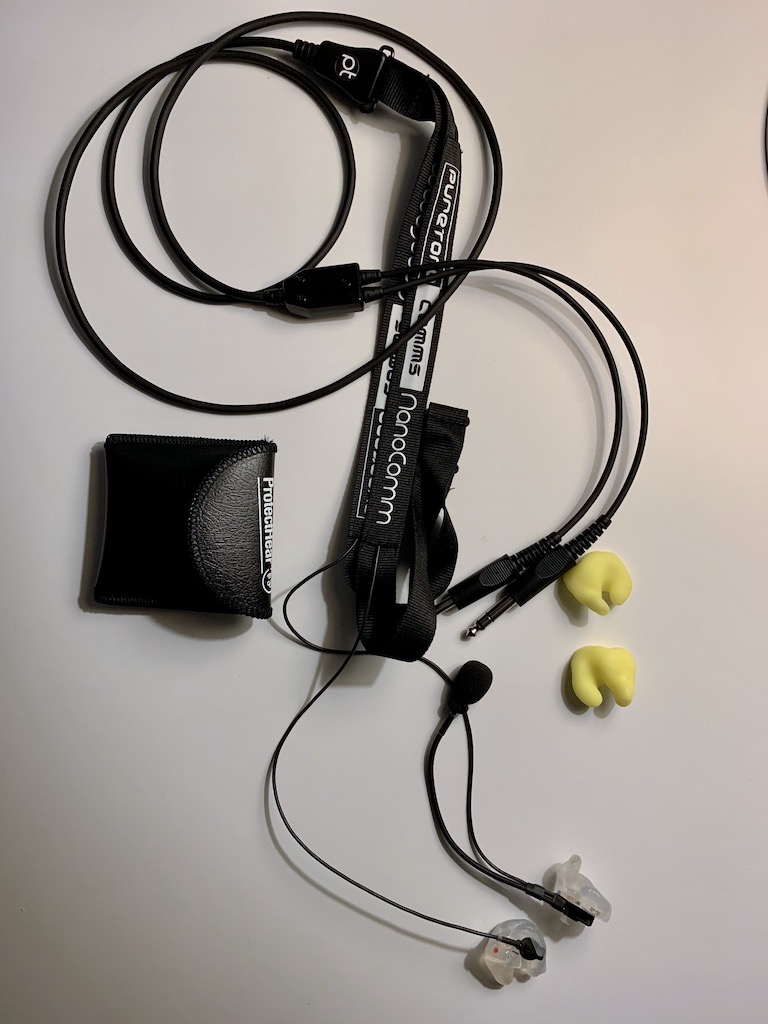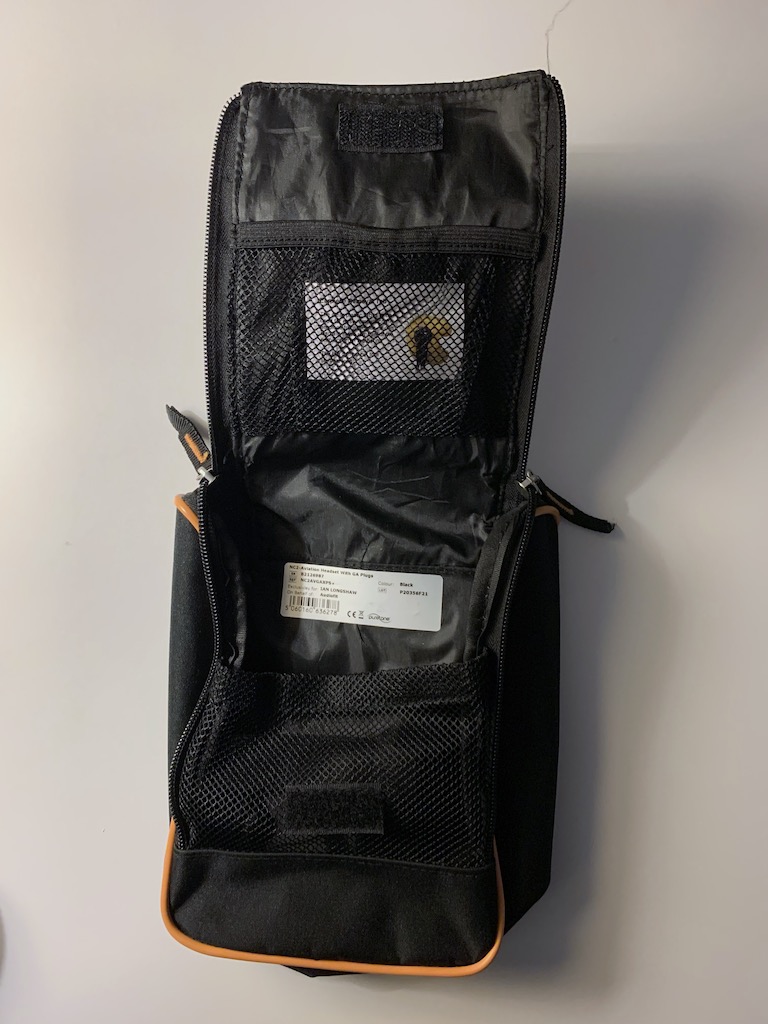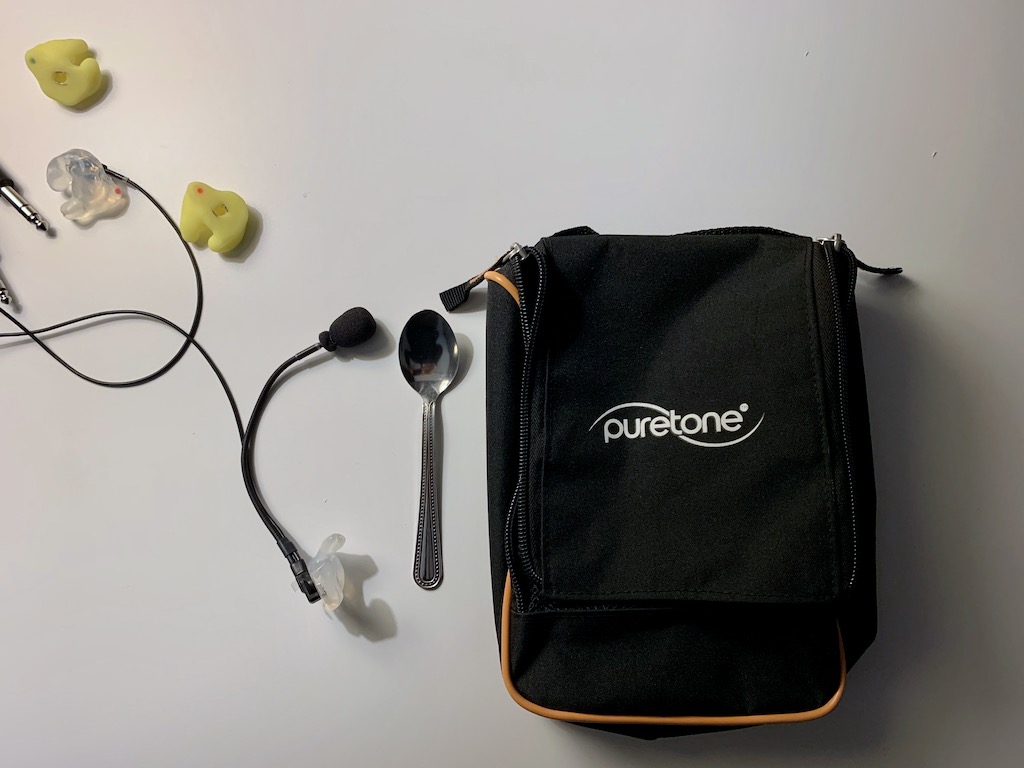This is a review of the NanoComm GA2 pilot headset from Puretone. In summary, I like this headset. It is small, lightweight and relatively inexpensive. Audio clarity is excellent but it is less effective at external noise suppression than an active noise-cancelling headset. My biggest reservation is the unproven durability of the clips and headset wiring. For anyone in the North of England looking to buy this headset, I would strongly recommend the services of Nigel from AudioFit for a simple one stop solution.
Background
Like many pilots I own an expensive noise-cancelling headset, in my case a Lightspeed Zulu 2, which has served me well for a few years now. However, towards the end of last year I had been looking at replacing my headset with something smaller as the Lightspeed takes up a substantial amount of space in my flight bag and and the dreaded intermittent crackle – which indicates a loose wire – had begun again.
I wanted something small and lightweight to save space in my bulging flight bag. Whilst noise cancelling would be a bonus, an in-ear design that blocked sound without the use of batteries was also a viable option. Finally given that my existing headset still worked- I couldn’t justify paying close to £1000 for a replacement so it needed to offer value for money.
Options
I have often admired the small size of the Bose QC15 and Bose QC25 headphones, paired with a third-party aviation microphone, as used by many of my colleagues. I initially looked at this as an option, but was put off by a lot of negative reviews concerning the durability of the headphones. Some pilots have also commented that the microphone connection is somewhat temperamental.
I also considered the relatively inexpensive and lightweight QT Halo which got many excellent reviews and would have bought one, but it seemed permanently out of stock, and I subsequently discovered, doesn’t ship outside of the USA.
Similarly I considered the Clarity Aloft which also uses an in ear design but price wise was getting into the same ballpark as the noise-cancelling offerings from the likes of LightSpeed, Bose, Sennheiser and David Clark.
Every now and again, an obscure headset called the NanoComm GA2 would appear in my search results but information was largely limited to the same description on a couple of websites, a brochure from Puretone and the odd discussion forum in South Africa. I could find no detailed reviews, but on paper it seemed to tick all the boxes.
I dug a little deeper but, as well as the lack of reviews, I was put off by need to arrange for ear impressions to be taken and sent to Puretone, to tie up with the order, and the related question of whether my ears would need syringing first. In addition, the order form offered two lengths of microphone and I had no idea which would be the better option.
AudioFit
It was at this point that I stumbled across the AudioFit website. Of the websites that I found, AudioFit stood out to me with a clean simple layout and importantly an all-in service and price, but it was late Spring before I picked up the phone to arrange an appointment.
I phoned the AudioFit number early evening expecting a voicemail but to my surprise the phone was answered and I had a long conversation with a pleasant and helpful gentleman, who turned out to be Nigel, the owner of AudioFit. Nigel gave me a lot of information about the headset and we booked in a date for me to visit for a fitting. He also took the opportunity to recommend an ear cleaning product to use in the weeks preceding the appointment to to ensure that the impressions could be done.
When we arrived at Nigel’s home he produced a NanoComm GA headset for me to look at and he demonstrated how to attach the wires to the earpieces and how to correctly insert the earpieces into the ear. Nigel then filled in the Puretone order form. On his suggestion, based on received pilot feedback, I opted for the longer microphone boom. Next, Nigel thoroughly explained the process of taking the impressions, the potential side effects – apparently some people can feel nauseous or faint during the process and then proceeded to check my ears for any issues or excess wax before taking the impressions one at a time. This was a quick and painless process taking three or four minutes per ear. Then with the bill paid, we left.
A few weeks later the headset arrived from Puretone.




The package contained:
- The headset cables contained within a lanyard. At the bottom end of the lanyard is a junction box with a volume control, a two-position microphone sensitivity switch and an auxiliary input. Note that the volume control is for received headset communications only and does not control the volume received from any device plugged into the auxiliary input. The decent length (2 metre) cable is finished with two GA connector plugs (other plugs can be ordered instead). At the top of the lanyard two thin wires terminate in small connector plugs, one of which has a boom microphone attached (amplified electret microphone with 300Hz-6000Hz frequency response).
- Two pairs of moulded earpieces, one yellow pair which filter the received audio and one clear pair without filtering. Both pairs offer the same level of external noise suppression (29dB SNR).
- A small hard case, presumably for storing the second set of earpieces.
- A small soft case, also presumably for storing the second set of earpieces.
- A zip-up carry case in black with orange piping.
- A user guide contained on a single folded sheet of A4 paper.
Setting up the headset for use was as simple as choosing which plugs to use (filtered or unfiltered) and clipping them onto the connector plugs. The earpieces themselves are made of a soft silicone substance but each one has a metal grip embedded to hold the clip in wires.

Once clipped in properly the earpieces seem quite secure and I have had no issues with them becoming unclipped by accident, although I would hesitate to remove and refit them unnecessarily as I suspect that over time this would result in them becoming loose. The clips are identical so the wire with the microphone boom can be fitted to either earpiece.
I started with the unfiltered earpieces and took them for a test run on a short flight from the Midlands to Edinburgh. At this point, let me say that my current ride is a Boeing 737 classic and I no longer fly any GA aircraft so can only comment on the headset as it performs in the Boeing. My first impressions were a mixed bag:
Firstly, the headset was great from a size perspective, it takes up very little room and when not in use hangs easily out of the way on the control column (or anywhere else for that matter).

Putting the earpieces in was a lot easier than I had anticipated, although there is a technique to it, and on later flights I found that there can be a considerable difference in outside noise if the earpiece is not fitted exactly right. Using a single earpiece with the attached microphone for ground communication whilst leaving the other earpiece hanging, to enable easy communication with my colleague, was completely without issue and it takes a matter of seconds to insert the second earpiece when required.
The audio was excellent, with the flight deck volume controls turned way down, ATC was loud and clear as were ground crew and my colleague on the flight deck. Colleagues with various different headsets have also confirmed that they can hear me clearly. I was disappointed, however, in the level of background noise as I had expected better noise suppression from the earpieces. I experienced the same on the next few flights and a few days later, decided to swap the unfiltered moulds for the filtered moulds. The difference was instantly noticeable, audio was slightly muted, although still clear but the background noise was considerably reduced.
I consulted with Nigel Hirst from AudioFit, on the phone. He was surprised that there was a difference in noise suppression between the two sets of ear pieces as both are 3D printed from the same mould, but following our discussion, and a simple home test, he sent me a pre-paid label and completed repair form to send all four earpieces back to Puretone for replacement, which I did.
Several weeks later, the replacements arrived and I have now been using them for about six weeks. For the record, I have gone back to using the unfiltered earpieces, as I have found that it is slightly easier to get a good volume balance between the radio and the intercom with the unfiltered set, although both give good audio clarity.
With the new earpieces the background noise is substantially suppressed. It is still louder than with an active noise-cancelling headset but, certainly in my environment it is more than acceptable, and I think, as long as the earpieces are inserted correctly, would be a good option in a GA cockpit. I would certainly choose the NanoComm GA2 over a non noise-cancelling headset in any environment.
Like any other headset it is not without it’s drawbacks so I have attempted to summarise below the good and bad points as I see them:
Pros:
- Small and lightweight.
- Excellent audio.
- No headband.
- No clamping or sweaty ear cups.
- Comfortable.
- Inexpensive.
- No batteries required.
Cons:
- The microphone boom can be difficult to position.
- Unproven durability of the earpiece clips.
- Unproven durability of the very thin headphone wires.
- Not as quiet as an active noise-cancelling headset.
I hope that this review is useful, please feel free to leave any questions or comments in the comments section or email questions to me here and I’ll answer them if I can.
